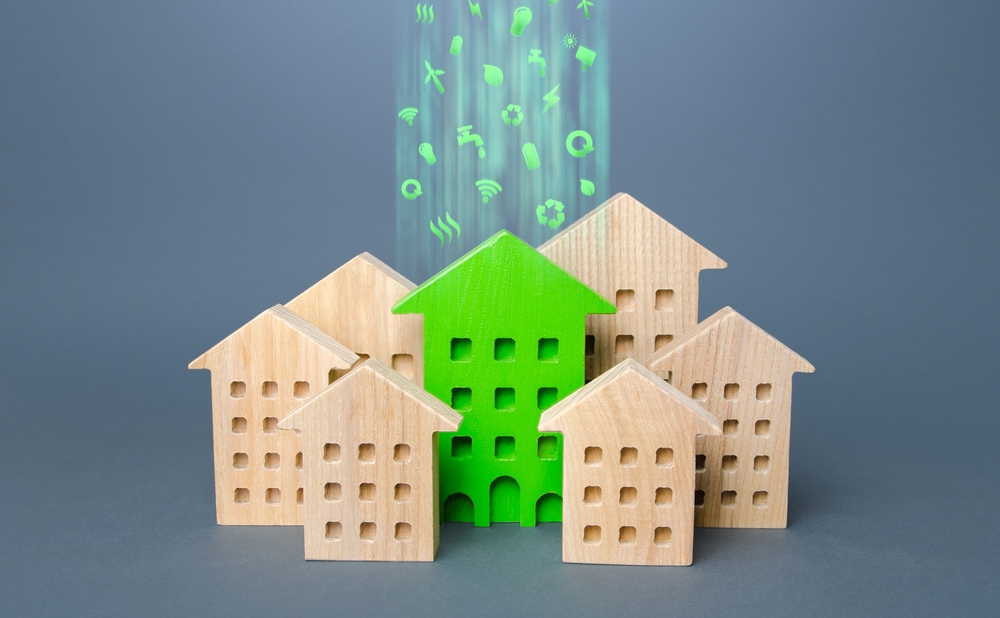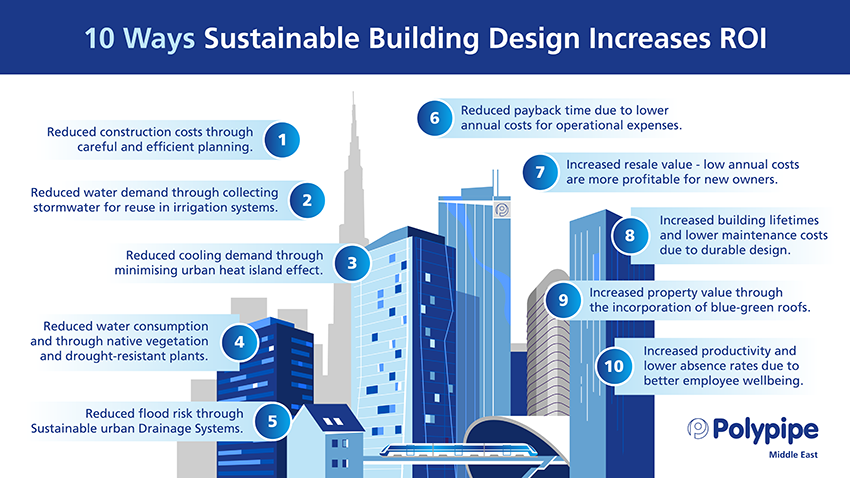Polystorm - Geocellular Water Management System
Polystorm is an efficient and versatile geocellular water management system for Sustainable urban Drainage Systems (SuDS) compliant attenuation, det

Sustainability, once a value-added benefit, has now become a collective societal goal. Greener practices are being increasingly adopted across environmental, economic, and social spheres, including into the construction industry.
However, in many parts of the world, barriers still exist that deter the construction of eco-innovative buildings and homes. In most cases, this is simply a problem of perception; the idea that increasing sustainability will incur added costs. Whilst it’s true that incorporating more sustainable practices could cost more upfront, truly sustainable buildings are created to deliver an attractive return on investment, showing how in the long-term, building owners and operators could actually save costs.
The benefits of sustainable design run beyond just cost. There’s also the question of human health and wellbeing. The adoption of more sustainable design practices often helps to create healthier indoor spaces that support improved indoor air quality, thermal comfort, and connection to the natural environment, among other things.
There’s no denying that we are experiencing a global shift towards creating more sustainable spaces. By adopting more sustainable practices, building owners and operators gain the ability to offer society what it seeks, and hence sell more and increase their profits.
For those operating in the construction industry, it’s important to recognise the many benefits sustainable design practices can offer, in the form of future financial returns and customer loyalty:
Lower Operating Costs
One of the main features of sustainably designed buildings is that they typically deliver lower annual costs for energy and water through integrated design and innovative use of sustainable materials and systems, allowing for more efficient resource use.
For example, strategically placed solar panels can be used to power buildings. This can reduce energy usage and thus save costs.
In fact, contrary to popular belief, it has been proven that green buildings, especially those built to meet LEED certified standards can cost the same or even less than a traditional building. This is because as ‘green’ becomes more mainstream, a higher variety of green products and services have become available.
For example, the use of smart HVAC has increased across the construction industry. The integration of smart pumps enables building owners and operators to gain insights on the performance of their HVAC systems and optimize accordingly. These systems can also allow for demand-based control to decrease energy wastage and reduce overall operating costs.
Improve Life Cycle Costing
The integration of eco-innovative design practices can add value to your building in many ways, spanning the entirety of the property’s lifetime.
For example, material selection for green buildings typically includes the use of sustainable and durable materials that are chosen to last. In the long run, this helps buildings last longer, decreasing the need for maintenance and repair and associated costs.
Creating more sustainable buildings also helps to increase property value. Homes in the UK that met third-party certifications, such as LEED, commanded prices that were 25% higher than those that didn’t.
And let’s not forget about the value it can add through reputation. Real estate investors assess building values based on cash flow and net operating income. Research shows that investing in sustainable design features, such as energy and water efficiency measures, can considerably increase the resale value of a property by lowering annual costs and therefore making the building more profitable for the next owner. To learn more about maximising ROI, read our blog on the topic here.
Furthermore, the sustainable nature of the building can be considered a symbolic message to building visitors and community members, enhancing the reputation of the building owner or property developer. Key aspects of the message conveyed by a sustainable or green building include technological advancement, architectural innovation, and concern for humanity and the environment.
Enhance Occupant Comfort and Health
Sustainable design features can promote better health, comfort, well-being, and productivity of building occupants.
For example, the integration of ‘green’ products and services such as high-performing drainage and ventilation helps to maintain healthier indoor air quality.
Our above-ground drainage range, Terrain, can protect occupants from the spread of infectious, hazardous fumes and air-borne diseases. It can also reduce the risk of harmful illnesses that stem from poor indoor air quality such as respiratory problems, sick building syndrome and asthma. Discover more about the profound role drainage places in occupant wellbeing here.
For office buildings, supporting occupant comfort and productivity can directly impact the bottom line. A green building should deliver a space which has healthy indoor air quality, plenty of natural light, comfortable noise levels, etc. All these factors, if optimised, can reduce levels of absenteeism and increase productivity.
Protect Our Most Precious Resource - Water
An important aspect of creating eco-innovative buildings is integrating Sustainable urban Drainage Systems (SuDS) to use water more efficiently.
SuDS mimic the Earth’s natural water cycle to capture, store, treat and reuse water. This focuses on reuse, differentiating itself from conventionally linear systems in which water is treated as a waste product. Rather than water running directly into sewage systems, which can cause them to overflow during extreme weather, SuDS harvest water as close to where it falls as possible through a source control strategy. The surface runoff is then collected into underground networks where sediments are filtered out. This water can be reused for irrigation and other sustainable applications.
At Polypipe Middle East, we offer two sustainable water management systems to help create green buildings.
Our multi-award winning Permavoid can be easily integrated into roof structures, beneath the growing medium. This helps to create green-blue roofs, which deliver a range of health, wellbeing, commercial and social benefits. The incorporation of green roofs also helps to increase property resale value. Learn more about such benefits of green roofs here.
Another SuDS solution that can be implemented into urban environments and contribute to green urbanisation is Polystorm. Each Polystorm cell has a 95% void ratio for maximum water capture and retention. This is crucial for areas that are considered to be vulnerable to floods since more stormwater can be detained within a given area.
Check out the full range of benefits in one infographic demonstrating 10 ways in which integrating sustainable design practices can help increase ROI:

As we move forward, it’s important to understand the true impact of sustainability in the construction industry. In some cases, it is in fact the most practical option. For example, Chicago’s push toward green roofs was based entirely on solving the problem of urban heat island effect in the city in an effective, long-term way.
Sustainable buildings don’t just benefit building owners and occupants, but their impact can be felt by the wider community too. The integration of sustainable buildings into our cities can reduce wastage, energy consumption, costs from air pollution damage and more, influencing city-wide infrastructure costs. By reducing energy consumption and waste generation, the widespread application of sustainable design principles to new construction and renovations will, over time, reduce the need for new infrastructure required to support buildings.
While sustainability may require more upfront investment, it is by no means an added cost. Not only will integrating sustainable design practices actually help from a financial point of view, but it also adds value in other ways - health, wellbeing, reputation, environmental and consciousness to name a few. How much are these worth to you?
If you’re wondering where to begin on the road to sustainability, read our Managing Director, Adam Smith’s interview with The Sustainabilist on the topic of creating a sustainable built environment.
Contact us today to find out more about how our eco-innovative solutions can help take your projects to the next level.
Tel: +971 (0) 4 518 3000
Email: middleeast@polypipe.com
Polystorm is an efficient and versatile geocellular water management system for Sustainable urban Drainage Systems (SuDS) compliant attenuation, det
Permavoid is a shallow geocellular water management system aimed at managing stormwater and surface water at source, as close to where it falls as pos
Globally respected for its international accreditation and durable solvent weld jointing methods, the Terrain PVC-u above ground drainage system has b